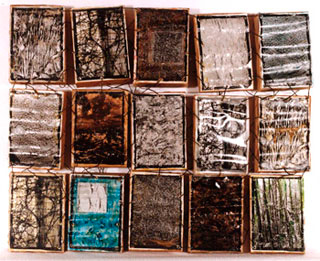“INSIDE ART: Steel Artist Lisa Issenberg”
by Rebel Muse
Telluride Magazine
Fall 1999
The beauty of everyday objects is something that has always fascinated local artist Lisa Issenberg. She recalls her days as an art student when she created linoleum cuts of toasters and blenders. “The objects we use every day are somehow invisible to many people. Andy Warhol helped change our perception—seeing the artistic merit in everyday objects by questioning their function and seeing the humor in their purpose.”
Issenberg’s own work is highly innovative, fusing steel with black and white photography to create a variety of art forms including jewelry, sculpture and furniture. Functional art is the underlying theme to most of her work. Take, for instance, her cafe chair. Is it art or is it a chair? The chair has simple lines, legs dressed in velvet stockings and a tiny photo of mountains on the backrest. You think twice about sitting on it, reluctant to turn your back to the local landscape. Still, the chair looks so inviting. This tension is how Issenberg gets her audience to reconsider what is functional.
Issenberg’s education includes a BA in social psychology from Tufts University. She’s also studied metal arts at the Rhode Island School of Design and silversmithing at the Boston Museum School of Art. She continued her fine arts education at San Francisco State University where she studied black and white photography. “I took photos in the city [San Francisco],” she says, “but my inspiration comes form nature.” Incorporating the photographs of places she loves into the work that she loves has become an Issenberg trademark. “It’s interesting to see how the impact of my black and white photographs changes in the different applications. When I put one in a necklace or bracelet, it becomes a very intimate, personal piece for the wearer. It’s something they can hold in their hand and hold sacred. When I put a photo on a larger sculpture, it draws the viewer into the piece; the sculpture now holds the viewer.”
The inspiration she finds in local scenery has evolved into an intriguing series of “bodyscapes,” where a photo of a nude is turned sideways, creating a silhouette reminiscent of a mountain landscape. The grainy images are difficult to decipher as either landscapes created from a female form or the female form of nature as she sees it. “I’m interested in that sensual point where a landscape and a human figure meet. That point is a bodyscape.”
Much of Issenberg’s current work involves sewing or stitching together different image elements. “Even though I was the one to cut up the image in the first place, when I put it back together with wire I become entwined in it. It speaks to that part of human desire to keep ourselves whole.”
This year, Issenberg experimented with sewing in a community setting. Using funds from the Telluride Council for Arts and Humanities, the School-To-Career Program and Timberline Ace Hardware, she engaged high school students in a project titled, “Our Landscape: A Collaborative Installation.” Students selected a black and white photograph of the Weminuche Wilderness by Issenberg that was then enlarged and divided into 36 sections. Every student received a section to recreate in charcoal. Each piece was dipped in wax and then the big picture was recreated from the sewn-together pieces. The 6-by-8-foot permanent installation now hangs in the foyer of the Telluride Middle/High School.
Issenberg has shared her knowledge with the community many times as one of the most sought-after teachers at the Ah Haa School for the Arts. “Teaching others helps me learn about myself,” she says. “I enjoy the challenge of putting what I do into words. Seeing other people overcome their fears or getting turned on to art is its own reward. And after working predominantly in isolation, it’s nice to work with others.”
To further her own functional arts education, Issenberg returns to school this year to pursue a master’s degree in industrial design at Pratt Institute in New York. Industrial design is nothing new to Issenberg. Last year the town commissioned her to create trashcans and recycling receptacles that can be seen on almost every corner of Telluride’s main street. Other examples of her work have sold at the Whitney Museum Store in New York City and can be found locally at the Telluride Gallery of Fine Art.

